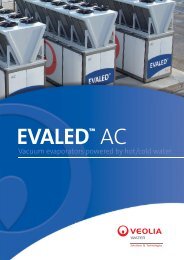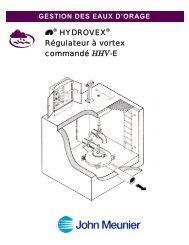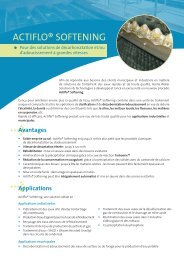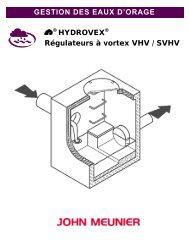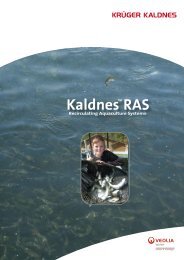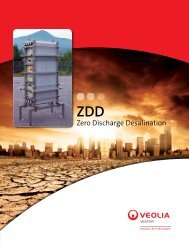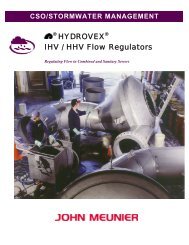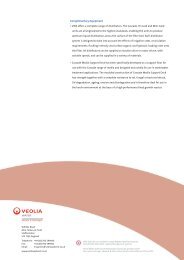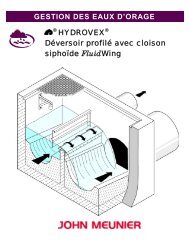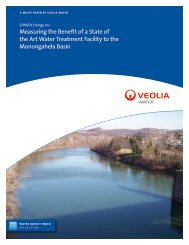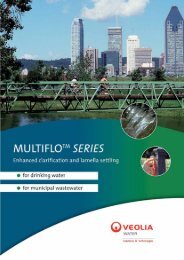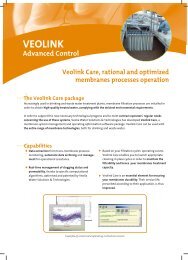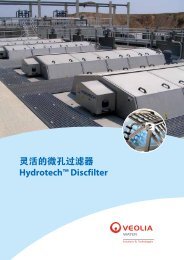Water Impact Index - Veolia Water Solutions & Technologies
Water Impact Index - Veolia Water Solutions & Technologies
Water Impact Index - Veolia Water Solutions & Technologies
You also want an ePaper? Increase the reach of your titles
YUMPU automatically turns print PDFs into web optimized ePapers that Google loves.
A New Tool for Ensuring Sustainability<br />
The <strong>Water</strong> <strong>Impact</strong> <strong>Index</strong><br />
and the First Carbon-<strong>Water</strong> Analysis<br />
of a Major Metropolitan <strong>Water</strong> Cycle<br />
<strong>Veolia</strong> <strong>Water</strong> has unveiled the <strong>Water</strong> <strong>Impact</strong> <strong>Index</strong>, the first indicator enabling a comprehensive<br />
assessment of the impact of human activity on water resources. This paper shares details on this<br />
new index, along with a company study believed to be the first-ever simultaneous analysis of<br />
water and carbon on a major metropolitan area’s water cycle.<br />
A WHITE PAPER BY VEOLIA WATER
“ Public authorities, citizens and industries must all work<br />
together to ensure the sustainable future of our local water<br />
resources. Richer and more robust data is required for<br />
building the necessary solutions.”<br />
Laurent Auguste<br />
President and CEO<br />
<strong>Veolia</strong> <strong>Water</strong> Americas<br />
Pressure on water resources. The next challenge for growth?<br />
70% of the planet is covered by water, but only<br />
0.7% of the global water resource is freshwater<br />
available to us, and it is very unevenly<br />
distributed across the planet.<br />
Unlike oil, for which there are multiple energy options,<br />
freshwater has no substitute. And unlike oil, our needs for<br />
water cannot be sustainably addressed by transporting<br />
water from water-rich areas to water-poor, high-demand<br />
areas. Over the next three decades, projected population<br />
and economic growth levels will, locally, push to the<br />
limit the stress on this finite resource. In turn, limits in<br />
freshwater availability could become the world’s main<br />
growth limitation factor, as areas such as Southern<br />
California have already begun to experience.<br />
There are solutions to this forming<br />
crisis. They will require that we become<br />
smarter in the way we manage water,<br />
which begins with understanding the<br />
impact we are having on this crucial<br />
resource. In short, we must become more<br />
water aware.<br />
People continue flocking to urban areas<br />
and will continue doing so. For the first<br />
time, cities house 50 percent of the<br />
world’s population – and by 2050, cities<br />
are expected to house 75 percent of humankind. Locally,<br />
this means greater population density and increased<br />
economic activity in and around cities, creating more<br />
pressure on local water resources through increased<br />
consumption and greater pollution from domestic and<br />
industrial sources. (In the developing world, 2.6 billion<br />
people do not have access to basic sanitation systems,<br />
and in the developed world the lack of smart<br />
management of aging infrastructure leads to growing<br />
pollution.) Globally, increased populations (literally, more<br />
thirsty mouths) prompt a greater water demand through<br />
increased need for:<br />
1) food production (Agriculture represents already<br />
more than 90% of the world’s water consumption<br />
and is expected to increase by 50% with population<br />
and economic development. It is also a key source of<br />
pollution to freshwater resources),<br />
2) energy production (the so-called water-energy nexus,<br />
“ Business and<br />
governance<br />
as usual will<br />
not suffice as<br />
competing<br />
demands for<br />
water escalate.”<br />
which demonstrates how energy production requires<br />
significant water resource) and,<br />
3) continued economic growth (most manufacturing<br />
processes can’t function without water).<br />
In states as far flung as Georgia and Nevada, communities<br />
are experiencing service inconveniences or stating<br />
serious concerns over their long-term water supplies.<br />
In other states, industrial projects have been halted<br />
as water resources are strained or their long-term<br />
availability becomes uncertain. Peering into the future<br />
and considering the escalating use of our limited<br />
freshwater resources essential for our direct use and for<br />
the ecosystems we depend on, it is easy to see how this<br />
strain can affect the lives of generations to come on each<br />
continent, in developed and developing nations alike.<br />
Business and governance as usual will not<br />
suffice as competing demands for water<br />
escalate. We need to manage this limited<br />
resource in a better and more sustainable<br />
manner by not wasting it, not polluting it, and<br />
by reclaiming more. Not doing so will limit our<br />
ability to grow our economies, and will put our<br />
industries and existing societies at risk.<br />
So, where do we start? To be smarter in our<br />
decision-making processes, we need to better<br />
understand the specific local nature of our<br />
water challenges and the specific impacts of our activities<br />
on freshwater resources. For this, cities, industries and<br />
citizens need data, smart-planning tools, and more<br />
effective best practices to ensure a successful, sustainable<br />
future that takes into account our new realities.<br />
<strong>Veolia</strong> <strong>Water</strong> has unveiled the <strong>Water</strong> <strong>Impact</strong><br />
<strong>Index</strong>, the first indicator enabling a comprehensive<br />
assessment of the impact of human activity on water<br />
resources. This paper shares details on this new index,<br />
along with a company study believed to be the first-ever<br />
simultaneous analysis of water and carbon on a major<br />
metropolitan area’s water cycle. As water, carbon and<br />
economics become more intertwined, our intent is to<br />
provide a first attempt at a new decision-making process<br />
grounded on sustainability. It is critical that we build<br />
a better understanding of how water resources and<br />
human activities can be managed to offset our collective<br />
environmental impact.<br />
2<br />
A WHITE PAPER BY VEOLIA WATER
The Freshwater Landscape<br />
Freshwater availability has been predicted to<br />
become a major limitation factor for growth<br />
for cities and industries in many locations<br />
around the world, and the need to understand<br />
and quantify the impact on water resources<br />
is essential to maintaining their sustainability<br />
and future prosperity because there is no<br />
substitute to water. This reality requires an<br />
understanding of the factors needed to make<br />
the most appropriate, sustainable decisions.<br />
Just as historians have connected the rise of great cities<br />
and economies with water (and in some cases, their<br />
demise), access to quality water resources is increasingly<br />
a focal point for those who plan for the future. In the<br />
developed world, urban planners, engineers, regulatory<br />
officials, environmentalists, politicians and those in<br />
charge of manufacturing operations are now focusing<br />
on whether their communities or operations will<br />
continue to have reliable access to water, necessary to<br />
ensure their continued development. Meanwhile, in<br />
the developing world, officials continue to grapple with<br />
the lack of infrastructure for basic access to water or<br />
sanitation that slows their ability to develop their societies<br />
and economies, and can even quite literally mean the<br />
difference between life and death.<br />
Are concerns about freshwater resources overblown? Are<br />
these matters for people far removed from our respective<br />
safe havens, especially for those located on lakes and<br />
riverways? Not when considering the EPA has already<br />
cited 36 states in the USA as facing water shortages and<br />
that industrial companies and investors are placing water<br />
risks on top of their list of strategic issues to address.<br />
Graphic of<br />
<strong>Water</strong> Stress <strong>Index</strong>, USA 1<br />
Stressed out?<br />
Populations continue<br />
to grow rapidly in many<br />
areas that are already<br />
experiencing water<br />
resource limitations.<br />
Populations are growing<br />
less rapidly where<br />
water resources<br />
are abundant.<br />
Consider the following:<br />
In the developing world where infrastructure is lacking,<br />
close to 1 billion people do not have proper access to<br />
healthful water, and 2.6 billion people are without<br />
sanitation systems. This triggers an incredible storm of<br />
health issues and water-borne fatalities, not to mention<br />
freshwater pollution and water resource pressure.<br />
At the same time, leakage rates in distribution networks<br />
in developed countries can exceed 50%, while the lack<br />
of proper maintenance of wastewater and stormwater<br />
collection networks leads to growing pollution.<br />
80% of all childhood deaths and illnesses in developing<br />
countries are directly or indirectly caused by lack of<br />
proper access to water or sanitation.<br />
By 2050, 75% of the world’s population will live in cities,<br />
increasing pressure on already strained water resources.<br />
Global demand for water will increase by 40% in just<br />
20 years – and is projected to double in rapidly<br />
developing countries.<br />
70% of today’s water withdrawals are used in<br />
agriculture. Population growth will lead to further<br />
significant withdrawals for agriculture, while fertilizing<br />
practices, if inappropriately managed, lead to an<br />
increasing source of water pollution affecting ground<br />
and surface water fresh resources.<br />
Climate change impacts will make the availability of<br />
freshwater resources more unpredictable. This includes<br />
droughts, floods and increased sea levels that can cause<br />
salt water intrusion in groundwater reserves.<br />
Pop, evolution (2000-2009)<br />
Average USA: +9.1% 2 Wisconsin: +5.4% 2<br />
California: +9.1% 2 Arizona: +28.6% 2<br />
Texas: +18.8% 2<br />
Based on the <strong>Water</strong> Stress <strong>Index</strong>, red represents<br />
areas that are experiencing higher levels of<br />
water stress while blue signifies areas with<br />
less or limited stress on water resources.<br />
Florida: +16.0% 2<br />
1 S. Pfister, A. Koehler, and S. Hellweg, 2009 “Assessing the environmental impact of freshwater consumption<br />
in LCA,” Environmental Science and Technology, no. 43, pp. 4098-4104<br />
2 U.S. Census Bureau, 2010<br />
A WHITE PAPER BY VEOLIA WATER 3
Half of the world’s population now<br />
lives in cities. By 2050, that number will<br />
increase to 75%, further straining water<br />
resources and systems.<br />
Similarly, consider how demand for water, coupled with<br />
a 2008 non-historic drought in the Southeastern United<br />
States, sparked fighting words between public officials,<br />
as well as a legal attempt to relocate a state line to secure<br />
more water resources. Concerned that water supplies<br />
would be exhausted within three months, Atlanta soon<br />
banned lawn watering, car washing and the filling of<br />
swimming pools. Lack of water has stopped commercial<br />
or industrial projects not just in California, but in Georgia,<br />
Tennessee, South Carolina, Idaho, Arizona and Montana.<br />
As populations shift more toward urban areas, current<br />
water and wastewater treatment programs may not<br />
be sufficient to address this and other trends involving<br />
climate change, energy consumption, pollution and the<br />
impact of human activity on ecosystems. In an age when<br />
our development often occurs further away from a local<br />
water resource or our use pushes them to their limit,<br />
ecosystems are being even further stretched.<br />
Current budgetary and economic challenges lay atop hard<br />
facts already on the table. As each drop of water becomes<br />
more precious, many cities are finding their leakage<br />
rates increasing. Even in North America, some cities can’t<br />
account for up to half of their water production! Analysis<br />
of federal data by The New York Times indicates that<br />
“more than 20 percent of the nation’s water treatment<br />
systems have violated key provisions of the Safe Drinking<br />
<strong>Water</strong> Act over the last five years,” adding that “the other<br />
major water law – the Clean <strong>Water</strong> Act – has been violated<br />
more than half a million times.” 3<br />
Mandates exist but cities are clearly struggling in a<br />
ping-pong match between the EPA’s demand to do the<br />
right thing and the cities’ lack of resources or lack of<br />
political will in situations where mayors are often trapped<br />
between their citizens’ long-term needs and short-term<br />
expectations. Similarly, cities and states are not routinely<br />
aligning their governance structures to match watersheds<br />
nor are they responding with more efficient management<br />
approaches:<br />
Our drinking water systems are aging; some are more<br />
than 100 years old.<br />
The American Society of Civil Engineers has given a “D-”<br />
to U.S. drinking water infrastructure and a “D” to U.S.<br />
wastewater infrastructure.<br />
The U.S. Conference of Mayors estimates that the<br />
EPA’s projected funding gap ($500 billion over 20 years)<br />
represents only 10-20 percent of what is needed ($2.5-<br />
$4.8 trillion over the next 20 years).<br />
<strong>Water</strong>-quality concerns about agricultural runoff and<br />
pharmaceuticals continue to be raised.<br />
With these challenges in mind, our decisions must<br />
consider many factors – not just whether water comes<br />
from our tap today.<br />
3 http://www.nytimes.com/2010/03/23/business/23water.html “U.S. Bolsters Chemical Restrictions for <strong>Water</strong>,” Charles Duhigg, March 22, 2010.<br />
4<br />
A WHITE PAPER BY VEOLIA WATER
A New Model: The <strong>Water</strong> <strong>Impact</strong> <strong>Index</strong><br />
<strong>Water</strong> is a very local resource and, unlike oil,<br />
there are no alternatives to water.<br />
Oil and natural gas can be transported over long<br />
distances, but transporting large quantities of water is<br />
not a practical option, especially considering sheer weight<br />
and the associated energy required to move such a heavy<br />
liquid. In Wisconsin, oil equivalent consumption is 8 tons<br />
per year on a per capita basis – water consumption is 2,140<br />
tons per year per capita.<br />
Current sophisticated water footprints focus almost<br />
exclusively on volume – a very good indicator to raise<br />
awareness but not sufficient to represent the impact on a<br />
water resource. For instance, we know that approximately<br />
2,900 gallons of water are required to make one pair of<br />
blue jeans. But what is the impact on a given freshwater<br />
resource – a reservoir, lake, river, etc.? Two examples<br />
illustrate this point.<br />
First, looking at two products – tomato sauce and<br />
peanuts – strictly by the volume of water needed, peanuts<br />
would appear to have a much higher water-use impact<br />
than tomato sauce. However, according to a study 4 on<br />
water stress-weighted footprinting, the opposite is true.<br />
Tomato sauce has a ten-fold greater impact on water<br />
resources than peanuts because tomatoes require more<br />
fertilizer and are produced in water-stressed areas with a<br />
significant reliance on irrigation.<br />
Why go beyond a volumetric approach?<br />
Volumetric approach<br />
Stress-weighted water footprints<br />
350 40<br />
300<br />
Gallons of water<br />
250<br />
200<br />
150<br />
100<br />
Applying impact<br />
assessment factors<br />
Gallons-eq of water<br />
30<br />
20<br />
10<br />
50<br />
0<br />
Tomatoes Peanuts Peanuts Tomatoes<br />
0<br />
In terms of sheer water usage, the production of peanut candies requires 6 times more water than the<br />
production of tomato sauce. However, tomato sauce impact is 10 times higher when factoring in water stress.<br />
A second example: the volume of water needed to<br />
produce one pound of beef – 1,857 gallons – appears to<br />
be the same regardless of whether the beef comes from<br />
a water-rich or water-poor area. But the impact on the<br />
water resource in two different states or, for that matter,<br />
two different areas of one state (East and West Texas, for<br />
example) can vary considerably.<br />
“ The <strong>Water</strong> <strong>Impact</strong> <strong>Index</strong> expands<br />
on existing volume-based water<br />
measurement tools by incorporating<br />
multiple factors such as volume,<br />
resource stress and water quality. ”<br />
4 Ridoutt, B.G., Pfister, S., 2010. A revised approach to water footprinting to make transparent the<br />
impacts of consumption and production on global freshwater scarcity. Global Environ, 20 (1), 113-120.<br />
A WHITE PAPER BY VEOLIA WATER 5
The <strong>Water</strong> <strong>Impact</strong> <strong>Index</strong> expands on existing volumebased<br />
water measurement tools by incorporating multiple<br />
factors such as volume, resource stress and water quality.<br />
It examines the impact of human activity on water<br />
resources and provides a methodology for establishing<br />
positive and negative implications of how water<br />
resources are managed. The new tool provides additional<br />
parameters needed to make informed choices about<br />
effective water management.<br />
Through the <strong>Water</strong> <strong>Impact</strong> <strong>Index</strong>, decision makers can<br />
factor in three essential elements – quantity of water<br />
used, level of stress upon water resources, and overall<br />
water quality – and develop a much more detailed, holistic<br />
and inter-related understanding.<br />
The <strong>Water</strong> <strong>Impact</strong> <strong>Index</strong> considers both direct and indirect<br />
influences of an activity from “cradle to grave”– whether<br />
managing a textile production facility or a wastewater<br />
treatment facility. It incorporates the volume and quality<br />
of the water extracted and released back into the<br />
environment and adds the <strong>Water</strong> Stress <strong>Index</strong> (which<br />
accounts for the level of stress on the resource). This new<br />
index gives us the water impact – and it includes indirect<br />
elements from the production chain such as energy,<br />
raw materials, chemicals, and waste generated. (See<br />
methodology on the next page.)<br />
Through the <strong>Water</strong> <strong>Impact</strong> <strong>Index</strong>, one can better evaluate<br />
how water users (humans and ecosystems) could be<br />
deprived of water resources through mismanagement of<br />
water or wastewater systems.<br />
A new metric for assessing water impacts.<br />
VOLUME<br />
• <strong>Water</strong> Quantity<br />
• Volume of water<br />
used - extracted<br />
and released<br />
STRESS<br />
• The <strong>Water</strong> Stress<br />
<strong>Index</strong><br />
• Local hydrological<br />
context, freshwater<br />
scarcity<br />
QUALITY<br />
• <strong>Water</strong> quality -<br />
extracted and<br />
released<br />
+ + =<br />
WATER<br />
IMPACT<br />
INDEX<br />
The <strong>Water</strong> <strong>Impact</strong> <strong>Index</strong> accounts for the impact of water resources generated by a human<br />
activity. It enables evaluation of how other water uses (both humans and ecosystems) could<br />
potentially be deprived of this resource - expressed in Gallon-WII-equivalent.<br />
6<br />
A WHITE PAPER BY VEOLIA WATER
METHODOLOGY<br />
A new metric for assessing water impacts.<br />
Direct <strong>Water</strong><br />
<strong>Impact</strong> <strong>Index</strong><br />
WII = WSI x [(V extracted x Q extracted ) - (V released x Q released )]<br />
Indirect <strong>Water</strong><br />
<strong>Impact</strong> <strong>Index</strong><br />
Energy<br />
Chemicals<br />
WII = WSI x [(V extracted x Q extracted ) - (V released x Q released )]<br />
Waste<br />
WII = WSI x [(V extracted x Q extracted ) - (V released x Q released )]<br />
WII = WSI x [(V extracted x Q extracted ) - (V released x Q released )]<br />
A <strong>Water</strong>-Carbon Analysis – the Milwaukee Example<br />
Carbon and water represent two major areas<br />
of impact on the environment that have broad<br />
economic and social ramifications.<br />
Producing energy and undertaking industrial activity<br />
require fresh water, and energy is needed to produce,<br />
move and treat water. This interdependence is often<br />
referred to as the “water-energy nexus.”<br />
Viewing carbon and water together provides a more<br />
comprehensive picture of the challenges to sustainability.<br />
Using less energy and less water results in lower<br />
pollution and less stress on ecosystems and water<br />
resources, preserving the balance for future generations.<br />
Also, reduction of energy and chemical consumption can<br />
limit wear and tear on assets and equipment, which can<br />
save money – an economic benefit for water utilities and<br />
the public.<br />
Developed in conjunction with <strong>Veolia</strong> <strong>Water</strong>’s <strong>Water</strong><br />
<strong>Impact</strong> <strong>Index</strong>, a study of the greater Milwaukee area’s<br />
water and wastewater systems (serving more than<br />
1 million people) assessed the interaction of carbon<br />
(energy) and water and their associated economic and<br />
environmental impacts. The study’s methodology<br />
assigned a value to water based on quality, quantity<br />
and resource stress. In essence, this study and the <strong>Water</strong><br />
<strong>Impact</strong> <strong>Index</strong> open a door to benchmarking water and air<br />
impacts from different activities throughout the world.<br />
One goal of this water-carbon analysis is to foster greater<br />
collaboration and continued dialogue around water<br />
and carbon measurement. As environmental efficiency<br />
grows in importance, organizations will be able to use<br />
this tool to determine business locations that create<br />
a smaller footprint. Similarly, water managers can<br />
recognize and adopt best practices that are meaningful<br />
for the environment, customers, and capital and<br />
operating budgets. Such actions, in turn, will help cities,<br />
businesses and organizations make the best possible<br />
decisions regarding sustainability when weighed against<br />
environmental outcomes and economic viability.<br />
A WHITE PAPER BY VEOLIA WATER 7
CARBON<br />
FOOTPRINT<br />
ECONOMIC<br />
FOOTPRINT<br />
WATER<br />
IMPACT<br />
INDEX<br />
A platform for awareness and<br />
making Sustainable <strong>Solutions</strong><br />
In Milwaukee, what is believed to be the first<br />
simultaneous water-carbon analysis of a major<br />
metropolitan water cycle was made possible by the<br />
<strong>Water</strong> <strong>Impact</strong> <strong>Index</strong> and through public and privatesector<br />
cooperation.<br />
VOLUME<br />
• <strong>Water</strong><br />
Quantity<br />
STRESS<br />
• The <strong>Water</strong><br />
Stress <strong>Index</strong><br />
QUALITY<br />
• Quality added<br />
into the <strong>Water</strong><br />
<strong>Impact</strong> <strong>Index</strong><br />
<strong>Veolia</strong> <strong>Water</strong>’s study of Milwaukee’s urban water cycle<br />
is believed to be the first-ever combined analysis of<br />
the water-energy nexus in a major community. The<br />
company chose Milwaukee for its pioneering study based<br />
on the city’s Lake Michigan location and because of its<br />
progressive actions in managing water resources.<br />
Milwaukee, in fact, is the only United Nations Global<br />
Compact City focused on freshwater management,<br />
which requires it to conduct a variety of water-quality<br />
projects that other cities can emulate. <strong>Veolia</strong> <strong>Water</strong> North<br />
America’s Technical Direction Group and the company’s<br />
global R&D team led the study in conjunction with the<br />
Milwaukee Metropolitan Sewerage District (MMSD), the<br />
City of Milwaukee, the Milwaukee <strong>Water</strong> Council, and<br />
other local partners and utilities.<br />
It should also be noted that <strong>Veolia</strong> <strong>Water</strong> and Milwaukee<br />
are partners in the largest U.S. wastewater partnership,<br />
allowing an efficient collaboration and facilitating data<br />
gathering and analysis.<br />
Findings in Milwaukee<br />
The Milwaukee-based water-carbon analysis yielded a<br />
number of findings on the local urban water cycle. These<br />
findings are local and results and findings may differ in<br />
other locations and for other utilities:<br />
The Carbon Footprint of the area’s water services<br />
is more than 310,000 tons CO 2 eq<br />
250,000<br />
200,000<br />
The carbon footprint for wastewater services is more<br />
than double the size of activities related to providing<br />
drinking water services.<br />
The Milwaukee area’s water<br />
and wastewater system has<br />
a carbon footprint equal<br />
to the carbon footprint of<br />
approximately 15,000 people.<br />
150,000<br />
100,000<br />
Electricity<br />
Steam<br />
Maintenance<br />
Natural gas<br />
Chemicals<br />
Freight<br />
50,000<br />
Process<br />
End of life<br />
Tonnes CO2eq<br />
0<br />
Drinking <strong>Water</strong><br />
Wastewater<br />
Capital works<br />
Travel<br />
8<br />
A WHITE PAPER BY VEOLIA WATER
<strong>Water</strong> <strong>Impact</strong> <strong>Index</strong> of Milwaukee-area’s drinking water<br />
and sewage system<br />
1800<br />
1606 MG WII eq/yr<br />
-87 MG WII eq/yr<br />
1518 MG WII eq/yr<br />
Drinking water production MMSD sewage system Total<br />
1600<br />
Drinking water production<br />
contributes to the <strong>Water</strong> <strong>Impact</strong> <strong>Index</strong>.<br />
<strong>Water</strong> of very good quality is<br />
extracted from its natural<br />
environment<br />
MG WII eq/yr<br />
1400<br />
1200<br />
1000<br />
200<br />
0<br />
MMSD sewage system reduces<br />
the <strong>Water</strong> <strong>Impact</strong> <strong>Index</strong>.<br />
<strong>Water</strong> quality is improved and<br />
brought back closer to<br />
environmental requirements<br />
The <strong>Water</strong> <strong>Impact</strong> <strong>Index</strong><br />
should be as low as possible<br />
to protect our resource.<br />
<strong>Water</strong> extracted from Lake Michigan is of a very<br />
good quality – and the MMSD system provides an<br />
improvement of -87 million gallons <strong>Water</strong> <strong>Impact</strong> <strong>Index</strong><br />
equivalent, bringing wastewater quality closer to the<br />
environment’s requirements.<br />
Public water conservation has a positive impact on<br />
water resources and carbon emissions, even in a waterrich<br />
urban environment like Milwaukee.<br />
The <strong>Water</strong> <strong>Impact</strong> <strong>Index</strong> shows that in Milwaukee, the<br />
positive impact of one gallon of treated wastewater<br />
returned to the environment is more than 400 percent<br />
lower than the <strong>Water</strong> <strong>Impact</strong> <strong>Index</strong> from one gallon of a<br />
combined sewer overflow (CSO).<br />
The <strong>Water</strong> <strong>Impact</strong> of proposed green solutions such as<br />
wetlands development, where stormwater would be<br />
separated from wastewater and sent to a wetland, is<br />
170% lower than treated wastewater.<br />
Since the development of the MMSD’s deep tunnels,<br />
annual overflows have been reduced by almost 8 billion<br />
gallons, based on 2009 levels, reducing very significantly<br />
the impact on local water resources.<br />
To reduce phosphorous levels in the wastewater<br />
effluent from approximately 0.66 mg/l to 0.3 mg/l<br />
(under consideration by MMSD), would reduce the<br />
<strong>Water</strong> <strong>Impact</strong> <strong>Index</strong> by more than 100% while slightly<br />
increasing the carbon footprint by 9% (for this part of<br />
the treatment).<br />
Chloramination (replacing the sodium hypochlorite<br />
disinfection by chloramination) would reduce related<br />
operating costs by 60%, the carbon footprint by 61%<br />
and the <strong>Water</strong> <strong>Impact</strong> <strong>Index</strong> by 65%.<br />
The carbon footprint from the drinking water<br />
distribution network of the main water utility<br />
(Milwaukee <strong>Water</strong> Works) is more than 20% higher<br />
than the one from its drinking water production side.<br />
Two-thirds of the carbon footprint from the works on<br />
the water distribution network of Milwaukee <strong>Water</strong><br />
Works is embedded in the metal pipes.<br />
Improving phosphorous removal - a substantial gain at a slight cost<br />
20%<br />
0%<br />
-20%<br />
-40%<br />
-60%<br />
-80%<br />
-100%<br />
-120%<br />
-140%<br />
-160%<br />
+7% -136%<br />
+7%<br />
<strong>Impact</strong> on CFP<br />
<strong>Impact</strong> on WII<br />
<strong>Impact</strong> on costs<br />
A reduction of phosphorous<br />
concentration in MMSD’s<br />
treated wastewater<br />
discharged into Lake<br />
Michigan to a 0.3mg/l level<br />
(concentration averages for<br />
2006-2007 were 0.66 mg/l)<br />
reduces the <strong>Water</strong> <strong>Impact</strong><br />
<strong>Index</strong> by more than 100%<br />
while slightly increasing the<br />
carbon footprint (around 400<br />
tonnes CO2eq per year) due<br />
to increased use of chemicals<br />
and energy.<br />
A WHITE PAPER BY VEOLIA WATER 9
A new project to replace natural gas and electricity<br />
demand via the use of landfill gas will significantly<br />
reduce the city’s carbon footprint and <strong>Water</strong> <strong>Impact</strong><br />
<strong>Index</strong> equivalent. Over 19 years, this would result in<br />
a savings of 1 million tons CO2eq (the annual carbon<br />
footprint output of 50,000 people) and 51 million<br />
Gallons of <strong>Water</strong> <strong>Impact</strong> <strong>Index</strong> equivalent.<br />
This landmark study of Milwaukee’s water cycle<br />
represents the first attempt at testing <strong>Veolia</strong> <strong>Water</strong>’s<br />
methodology. More important, it establishes a tool for<br />
determining the most sustainable course of action based<br />
on available resources. For example, the study showed<br />
that air and water impact assessments do not replace<br />
thorough economic evaluation of a project or activity.<br />
Rather, they complement it by providing a multi-criteria<br />
analysis to achieve a “best-in-class” decision-making<br />
process. The unique circumstances of particular locations,<br />
ecosystems, economies, community needs and goals<br />
could lead to varied conclusions.<br />
One of the next steps will be to extend the analysis to<br />
additional urban or state areas. Through this study, public<br />
and private sectors have worked closely in a way that<br />
provides a model for governments, organizations and<br />
businesses to provide best practices toward responsible<br />
water management and sustainable living.<br />
Chloramination represents a win-win-win situation<br />
<strong>Impact</strong> on CFP<br />
<strong>Impact</strong> on WII<br />
0%<br />
-10%<br />
-20%<br />
-30%<br />
<strong>Impact</strong> on costs<br />
Switching from sodium<br />
hypochlorite disinfection to<br />
chloramination would<br />
reduce the <strong>Water</strong> <strong>Impact</strong><br />
<strong>Index</strong> of chemicals, the<br />
carbon footprint and<br />
generate savings.<br />
-40%<br />
-50%<br />
-60%<br />
-70%<br />
-61%<br />
-65%<br />
-60%<br />
Milwaukee’s Jones Island Wastewater Treatment Facility<br />
10<br />
A WHITE PAPER BY VEOLIA WATER
Conclusion<br />
There is no question that human and<br />
environmental preservation requires sensible<br />
use of water resources, but we also come<br />
to a point where economic growth will also<br />
dramatically depend on it.<br />
The challenge – for cities, governments and companies –<br />
is to find solutions that make a minimum impact on the<br />
environment not only in terms of water resources but<br />
also when it comes to energy use while maintaining and<br />
promoting economic growth.<br />
Rapid development is putting a strain on cities,<br />
particularly their water resources. Those communities<br />
that have not addressed their infrastructure needs will<br />
face huge wake-up calls that will challenge their political<br />
and economic stability. Today’s economic downturn only<br />
exacerbates the problem in budget-constrained cities<br />
and towns.<br />
When communities optimize their water and wastewater<br />
systems through technical and operational solutions, the<br />
benefits in service improvements, environmental impacts<br />
and cost savings for the public can be immediately<br />
realized. They also provide a framework for economic<br />
growth and prosperity.<br />
Everyone has a responsibility to conserve and manage<br />
natural resources wisely and with an eye to the future.<br />
Through the creation of the <strong>Water</strong> <strong>Impact</strong> <strong>Index</strong>, <strong>Veolia</strong><br />
<strong>Water</strong> has made a start toward a more rational and<br />
objective way to manage water and energy for years<br />
to come.<br />
<strong>Veolia</strong> <strong>Water</strong>’s <strong>Water</strong> <strong>Impact</strong> <strong>Index</strong> and water-carbon<br />
analysis are important steps in a broader dialogue about<br />
water, energy and the environment. As the need for<br />
environmental efficiency and resource management<br />
intensifies, organizations and communities will be able to<br />
use these tools to determine business practices (locations,<br />
operations, technologies, etc.) that create the minimum<br />
environmental impact and pose reduced risks to water<br />
and air.<br />
Milwaukee’s Southshore Wastewater Treatment Facility<br />
A WHITE PAPER BY VEOLIA WATER 11
About <strong>Veolia</strong> <strong>Water</strong> and the Milwaukee Partnership<br />
As the world’s leading provider of comprehensive water<br />
and wastewater services and technologies, <strong>Veolia</strong> <strong>Water</strong><br />
brings 150 years of experience, leading-edge technology<br />
and unmatched management skills to municipal and<br />
industrial customers worldwide.<br />
Based in Chicago, <strong>Veolia</strong> <strong>Water</strong> North America is<br />
the leading provider of comprehensive water and<br />
wastewater partnership services to municipal and<br />
industrial customers, providing services to more than<br />
14 million people in approximately 650 North American<br />
communities. The company is part of the <strong>Veolia</strong><br />
Environnement companies in North America, with<br />
30,000 North American employees providing sustainable<br />
environmental solutions in water management,<br />
waste services, energy management, and passenger<br />
transportation.<br />
<strong>Veolia</strong> <strong>Water</strong> North America and Milwaukee are partners<br />
in the largest U.S. wastewater partnership, providing<br />
operations and maintenance (O&M) services for two large<br />
wastewater treatment facilities, a substantial biosolids<br />
operation producing Milorganite® (a branded Class A<br />
Exceptional Quality organic fertilizer), along with system<br />
management of a 411-square-mile service area with a<br />
3,000-mile system of interceptor and main sewers. <strong>Veolia</strong><br />
<strong>Water</strong> is also funding a $1.5 million, 10-year R&D program<br />
in partnership with the Great Lakes WATER Institute –<br />
at the University of Wisconsin-Milwaukee, Marquette<br />
University and the MMSD.<br />
<strong>Veolia</strong> <strong>Water</strong>, the water division of <strong>Veolia</strong> Environnement,<br />
is the world leader in water and wastewater services and<br />
technological solutions. <strong>Veolia</strong> Environnement (NYSE:<br />
VE and Paris Euronext: VIE) is the worldwide reference<br />
in environmental services. With more than 312,000<br />
employees, <strong>Veolia</strong> Environnement recorded annual<br />
revenues of $50 billion in 2009. Visit the company’s<br />
Web sites at www.veolianorthamerica.com and<br />
www.veoliawaterna.com.<br />
12 A WHITE PAPER BY VEOLIA WATER<br />
www.veoliawaterna.com





